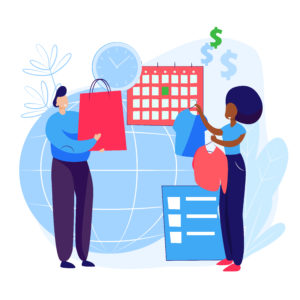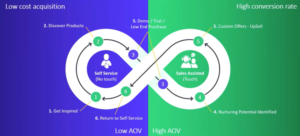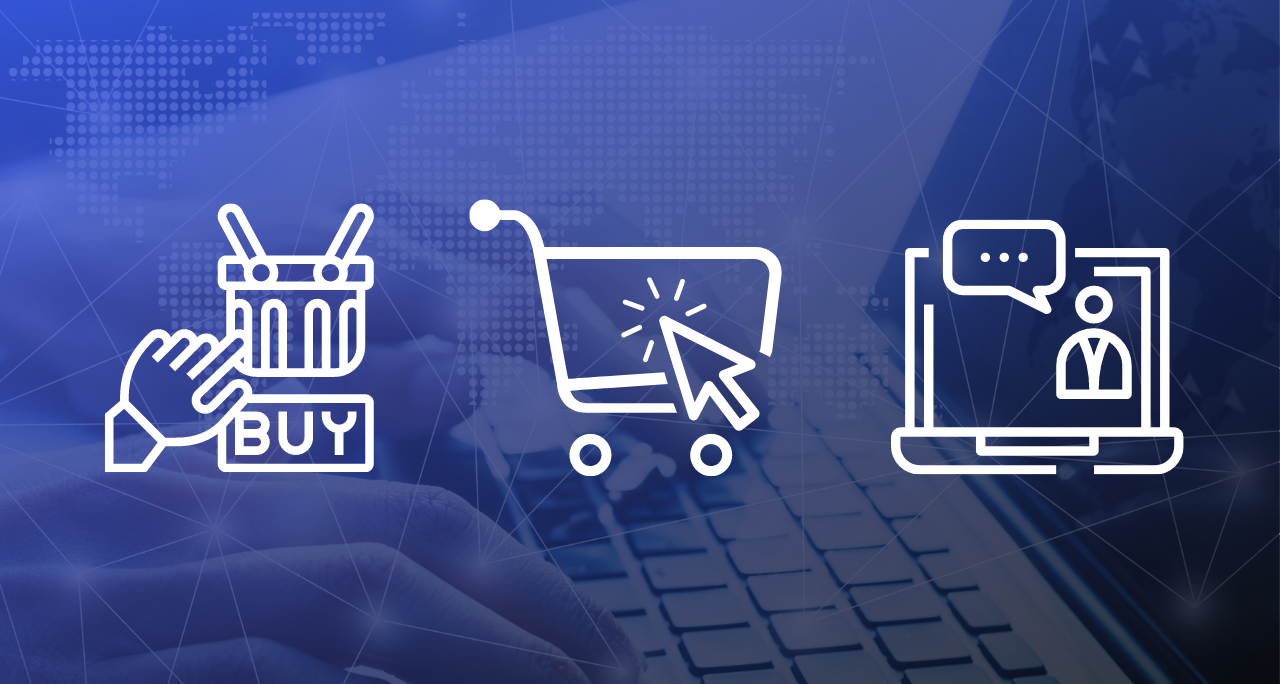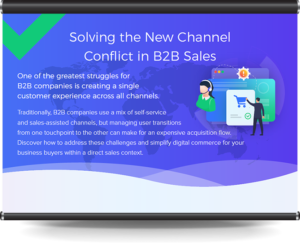B2B eCommerce has seen dramatic growth over the years. If you want to connect with the modern B2B buyer, the right eCommerce strategy is just the thing to put you ahead of the competition.
But while eCommerce is fast becoming the preferred sales channel for B2B consumers, many businesses still find themselves struggling to keep their B2B leads from falling through the cracks.
If you’re in the same boat, chances are that your self-service and assisted sales are at odds.
You can fill up your B2B sales pipeline with hot leads, or roll out marketing campaigns to keep them invested in what your product can do. But if you don’t bridge the gap between these two channels, your leads will end up stuck in the “Lead Purgatory.”
Want to learn how you can align your self-service and sales-assisted channels and help your prospects move seamlessly along your sales funnel? Keep reading to find out.
The great B2B eCommerce shift
The world of B2B eCommerce is changing, and fast.
According to a Merit report, 73% of B2B decision-makers are Millennials—you know, the digital-savvy generation that prefers to buy their stuff online. While most of their online transactions are in B2C, these B2B buyers’ purchasing behavior has extended to the B2B environment.
No wonder B2B eCommerce’s growth has accelerated at an astonishing rate. McKinsey reports that 75% of B2B buyers prefer to purchase online instead of buying directly from a salesperson. A Digital Commerce 360 study also shows that sales on B2B eCommerce sites went up by 10% to $1.39 trillion in 2021 from $1.26 trillion in 2019.
It goes to show what we’ve known all along: the modern B2B buyer is accustomed to speed, convenience, and personalization. If you want them to give your business the time of day, your B2B selling model should provide them the same level of ease and convenience a B2C storefront offers them.
The best way to do that is to use a self-service eCommerce platform on your website. It empowers them as consumers and allows them to become customers on their own terms.
However, if you want them to give your self-service channel the time of day, you need to catch their attention first.
Implementing a customer-centric omnichannel strategy
Selling to B2B buyers takes time. And you can count on them to do a ton of research before they reach the point of purchase. Before buying, they will scour different channels to find solutions that will address their needs and challenges.
You need an omnichannel strategy to capture and hold your audience’s attention long enough to become paying customers. You have to create content for each stage of their buyer journey. You need to leverage multiple B2B sales channels to reach them at significant touchpoints in that journey. And you need to deliver a consistent experience for those touchpoints to count.
In other words, you need to rely on blog articles, email marketing, referrals, customer reviews, and testimonials if you want to move your B2B prospects through your sales funnel.
The 2020 Chief Marketer B2B Marketing Outlook Survey shows that email (50%) is the B2B sales channel that produces the highest ROI, followed by search engine optimization (43%), content marketing (34%), and live events (32%).

This is where leads end up in “Lead Purgatory”
While you can capture leads using the above channels, your sales team has to close those leads to make them count. This is where leads usually fall through the cracks.
B2B leads fall into “lead purgatory” when the sales process pushes them into a path they’re not prepared to take. This happens because of the disconnect between the marketing team (lead generation) and the sales team (closing leads). The marketing team’s job is to attract leads while the sales team’s job is to close those leads. While their respective roles are both means to a common end, they often set the wrong expectations for potential buyers.
Thankfully, the benefits of customer self-service allow you to close that gap. After all, what better way to set the right expectations than to let prospects experience the value of your product even before the actual sale?
How to build a self-service sales model
B2B self-service is nothing new. In fact, you probably have some elements of it already in your B2B sales process. The goal of a sales-service model is to create a “self-service flow,” which empowers B2B buyers to solve issues on their own without direct help from your company.
Here are the elements you need to build a self-service sales process:
- Marketing automation
- Lead nurturing program
- A frictionless entry point (free-trial, freemium, etc.)
- Usage analytics
- Easy-to-use tools for configuring account elements
The goal is to organize these disparate elements into one coherent strategy, and in a way that makes the entire experience both customer-centric and journey-centric.
If you’re going to empower your prospects, you must deliver value to them even before the actual sale while allowing them to take ownership of the entire experience.
To be more specific, a self-service sales model allows buyers to start, end, upgrade, downgrade, and modify their subscription any time, depending on their limitations and situational needs.
In short: Your self-service channel must give customers what they need to help themselves. And that’s without outside help—unless they want it.
This brings us to…
Assisted Sales: the need for the human touch
Having a self-service channel is great, but that doesn’t mean you don’t need a sales team.
As much as B2B customers want to navigate their buying experience on their own terms, most of them will need some hand-holding or require the “human touch” to get comfortable enough to become paying customers.
In fact, according to an AppDirect study, 90% of first-time transactions worldwide require live assistance from a sales or support rep.
Hardly surprising. After all, B2B purchases have always involved a lot of risks.
Some of the questions that might be running the B2B buyer’s mind when trying to make a decision include:
Will the product perform as expected?
Will this generate ROI?
Will our production schedule be disrupted?
Will this purchase sour my relationship with my colleagues and shareholders?
You don’t overcome their reservations and objections by giving them the hard sell.
This is where assisted sales can help.
What’s an assisted sale again? Simply put, it is the process where a sales rep steps in to engage in consultative selling.
In other words, an assisted sale is a sales approach that prioritizes relationship-building with prospects and customers, engaging them in conversations that help identify and address their needs.
People from assisted sales are not in the business of chasing leads. They’re in the business of coaching users. Their job is to track and identify where users run into problems and then help them address and find a solution to those problems.

Breaking the wall between self-service and assisted sales
As we’ve established, you need both self-service and assisted sales to meet the modern B2B buyer’s needs.
Many B2B merchants already know this and some are already adopting this hybrid B2B eCommerce approach.
That’s good and all. The problem? Their self-service and assisted sales are working in silos.
This causes friction between the two channels. Without a single place to capture feedback and data, insights get mixed up and get lost in the noise.
Both channels become an echo chamber, pushing leads across the threshold back and forth based on loose criteria, not on clear distinctions that reflect their changing needs.
Client history loses all context. Your salespeople waste time and resources selling to people who shouldn’t or aren’t ready to buy your product instead of helping high-value leads who needed focused and more meaningful assistance.
If you want to create a seamless buying experience for B2B customers and accommodate a wide range of leads based on their unique needs, bridge the gap between these two sales channels.
You must break the wall.

Easier said than done. But not impossible. Especially if you have the right solution.
Use Commerce Automation to break the wall
You need a Commerce automation tool to knock down that wall. While your tech stack may already involve using CRM or digital commerce solutions, a Configure Price Quote (CPQ) solution can be the final piece that bridges your sales process synergy.
Oana Trif, Director of Product, Global eCommerce at Verifone, sums up perfectly how a CPQ solution can improve the B2B client experience and the sales process.
“CPQ is the tool designed to help your business create buyer-centric experiences for your prospects and clients, with capabilities to consolidate and synchronize your self-service interactions and your assisted sales processes into a comprehensive user journey, managed from a single platform. This type of tool features options to configure product offerings, prepare, negotiate and sign quotes and proposals, pricing and discounts set-up, and many more.”
In other words, CPQ functionality gives your assisted sales team superpowers, allowing them to close deals like never before.
CPQ software can benefit your business in the following ways:
- Shorter sales cycles. CPQ allows you to provide accurate quotes quickly, securing customer business and preventing prospects from switching to competitors.
- Automated reporting. Delivers real-time data to unlock invaluable customer insights that allow you to improve your solution and sales process.
- Increased sales productivity. Your sales team can focus on relationship-building and consultative work, allowing them to close more deals and giving them more upsell and cross-sell opportunities.
- Greater accuracy. Because the quoting process is automated, human error is taken out of the equation. Higher accuracy translates to fewer quote revisions, opening up resources for more high-value sales processes.
- Increase in revenue. CPQ lets you meet your customers’ needs at low costs, giving you a dramatic revenue boost.
The best part, of course, is how it eliminates friction between self-service and assisted sales. In other words, it helps both departments to collaborate seamlessly, streamlining internal operations and allowing them both to gather, aggregate, and categorize feedback and usage data accordingly.
This breaks down the wall between the two channels, facilitating a smoother flow between them and creating the “B2B Sales Infinity Loop.”

The infinity loop illustrates how B2B buyers navigate and experience your brand. It also gives you a blueprint on how you should be looking at your sales processes, in a way that gives prospects and buyers the flexibility to switch between channels based on their preferences and situational needs. Using a CPQ solution ensures you can automate and streamline your assisted sales side, effortlessly moving customers across the divide, depending on how much “touch” their stage in the funnel, and personal preferences, call for.
Over to you
Your self-service and sales-assisted don’t have to be at odds with each other. In a business landscape that grows increasingly complex by the day, you need both to create exceptional and personalized customer experiences.
Creating synergy between self-service and sales-assisted can be challenging, but with a leading digital solution like 2Checkout (now Verifone), you can close that gap, leading to higher sales, happier customers, and increased revenue. For an overview on why you siloed sales channels are hurting your business, check out this infographic.






